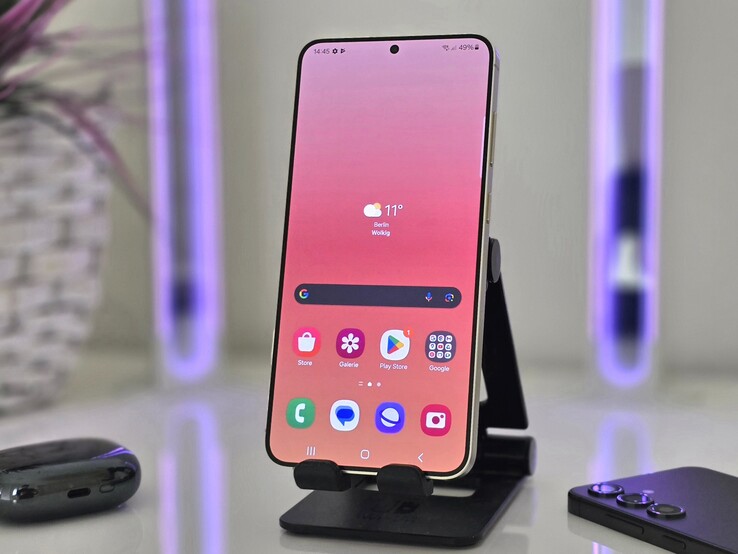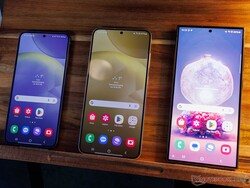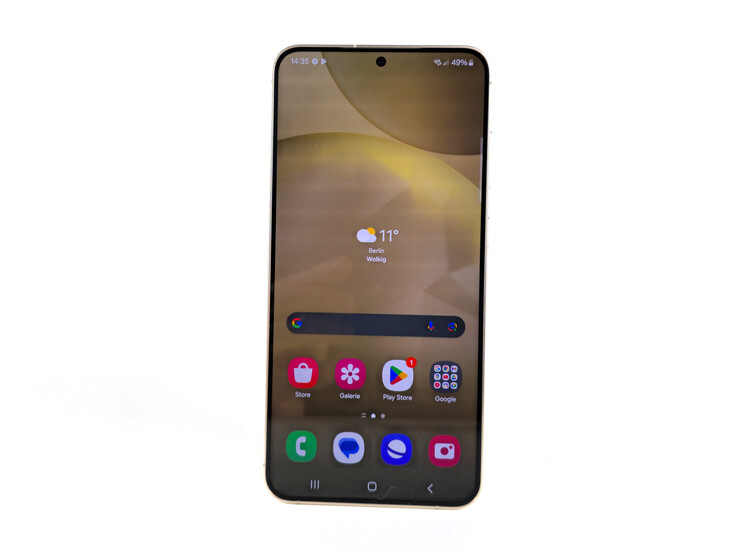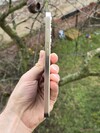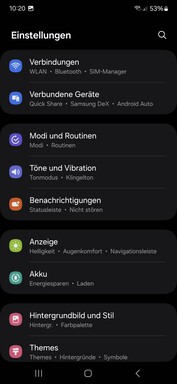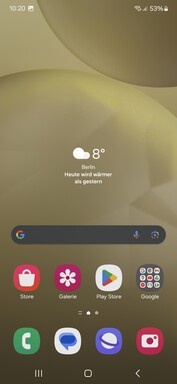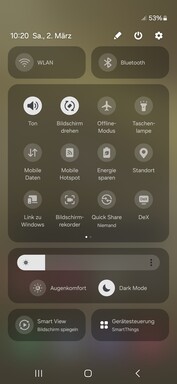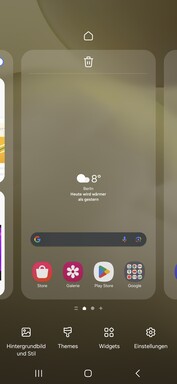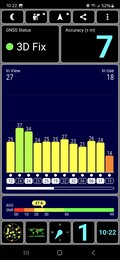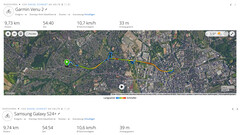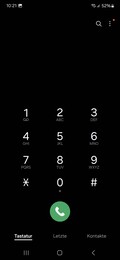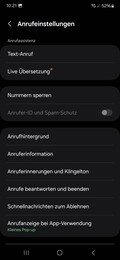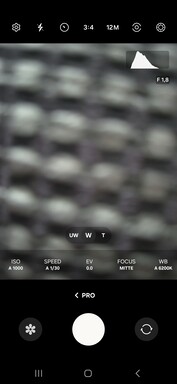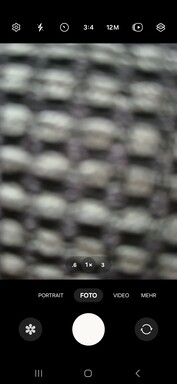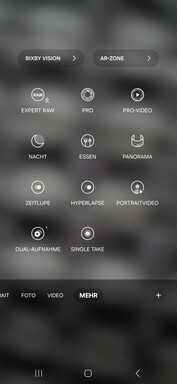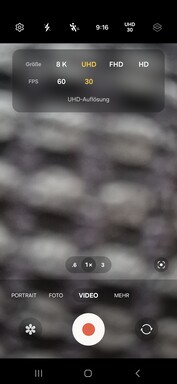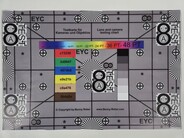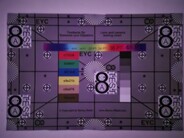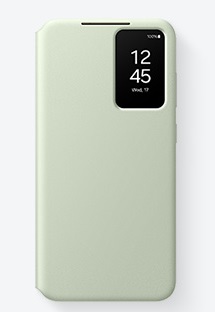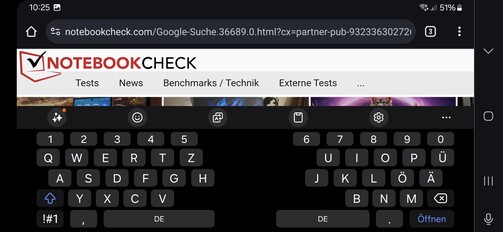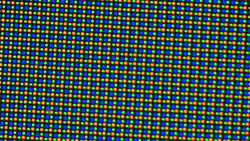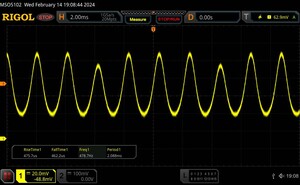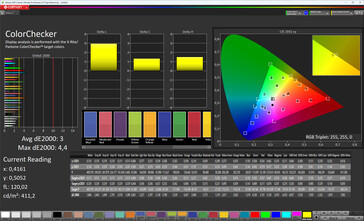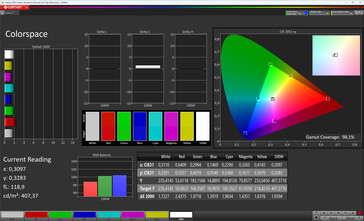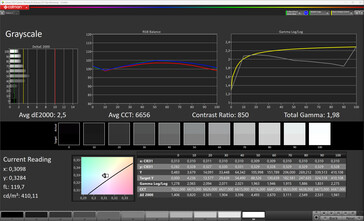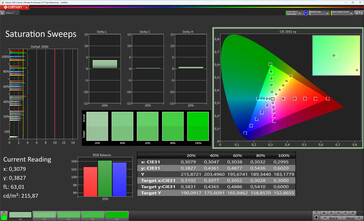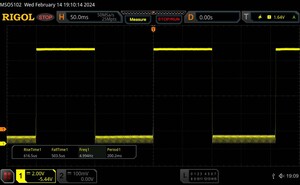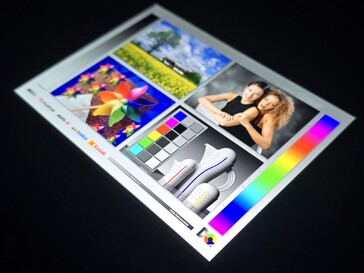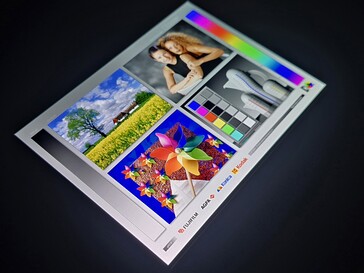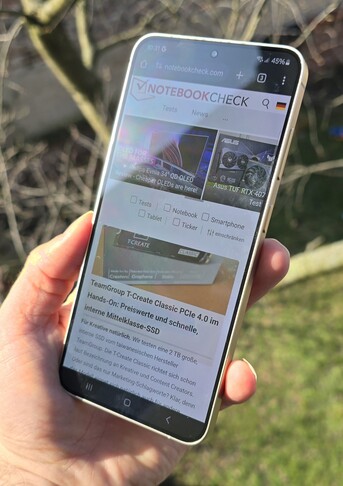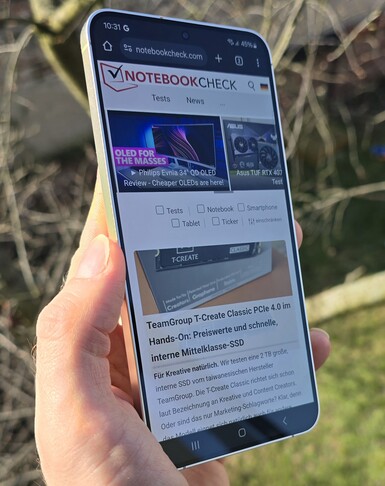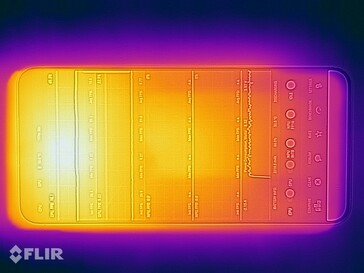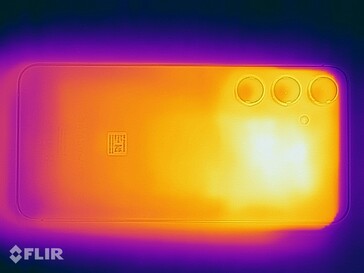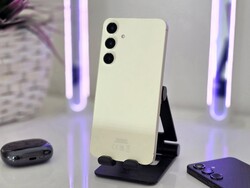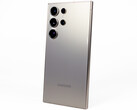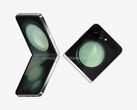Samsung Galaxy S24+ smartphone review: The big Galaxy S24 inches closer to the S24 Ultra
According to its tech specs as well as its price, the Galaxy S24+ is situated right between the compact Galaxy S24 and the S-series flagship, the Galaxy S24 Ultra. For an MRSP of US$999.99, buyers of the Plus model will receive 256 GB of internal storage and for a surcharge of US$200, its UFS-4.0 storage device comes with twice the capacity.
Compared to its predecessor, Samsung has improved its high-end smartphone in quite a few areas. Now, the Galaxy S24+ features 12 GB RAM as standard and the Plus model's WQHD+ display inches closer to the S-series Ultra smartphone. The same as on its smaller sister model, this year's Galaxy S24+ doesn't use a Qualcomm chipset but instead, relies on the in-house Exynos 2400.
Possible competitors compared
Rating | Date | Model | Weight | Drive | Size | Resolution | Best Price |
|---|---|---|---|---|---|---|---|
| 89.8 % | 03/2024 | Samsung Galaxy S24+ Exynos 2400, Xclipse 940 | 196 g | 512 GB UFS 4.0 Flash | 6.70" | 3120x1440 | |
| 90.3 % | 03/2023 | Samsung Galaxy S23+ SD 8 Gen 2 for Galaxy, Adreno 740 | 195 g | 256 GB UFS 4.0 Flash | 6.60" | 2340x1080 | |
| 89.4 % | 12/2023 | Xiaomi 14 Pro SD 8 Gen 3, Adreno 750 | 223 g | 256 GB UFS 4.0 Flash | 6.73" | 3200x1440 | |
| 89 % | 12/2023 | Google Pixel 8 Pro Tensor G3, Mali-G715 MP7 | 213 g | 128 GB UFS 3.1 Flash | 6.70" | 2992x1344 | |
| 86.8 % | 02/2024 | Nubia Z60 Ultra SD 8 Gen 3, Adreno 750 | 246 g | 512 GB UFS 4.0 Flash | 6.80" | 2480x1116 |
Case - The Galaxy S24 Plus with an IP certification
The IP68-certified high-end Samsung phone's build quality is excellent—there are no gaps or build issues. The used materials feel high-quality and the buttons sit securely within the Armor aluminum frame. The phone's back and front make use of Corning Gorilla Glass Victus 2.
Thanks to its slimmer bezels, the 6.7-inch Samsung Galaxy S24+ features very similar external dimensions compared to its predecessor and has grown by only 0.1 inches. This results in a slightly more efficient display-to-surface ratio of 91.6 per cent, giving the device a very modern feel.
Connectivity - The Samsung phone with UWB
The UFS-4.0 storage in our test sample has an available capacity of 463 GB and the internal storage cannot be expanded. The Galaxy S24+ features extensive connectivity options including NFC, USB-OTG, Miracast as well as USB 3.2 (Gen 1) with wired picture output support. In contrast to its smaller sister model, it also includes an ultra-wide-band chip, meaning the Galaxy S24 Plus can be used alongside the Galaxy SmartTag 2, for example, for extremely precise locating. When it comes to Bluetooth, the phone continues to only offer the 5.3 standard, as the installed Exynos 2400 doesn't support the newest version (5.4).
During our copying test using a connected M.2 SSD (Samsung 980 Pro), the device's USB port achieved transfer rates of 190 MB/s, which is considerably below the port's capabilities. The data systems exFAT and NTFS—which is preferred by Microsoft systems—are mastered by the Samsung phone, however, it can only read an NTFS-formatted drive and not edit it.
Software - The Samsung smartphone with long updates
The Galaxy S24+ runs the latest Android 14 and the in-house OneUI user interface (version 6.1), which includes the new Galaxy AI. If you want to find out more about Samsung's smart AI solutions, you can read about them in our review of the Galaxy S24.
At the time of testing, the Galaxy S24+'s latest security patch was from February, so very up-to-date. Samsung guarantees updates for seven years and seven major Android generations for its top-of-the-range devices. According to the manufacturer, security patches are to be rolled out monthly, although it is unclear over what period.
Communication and GNSS - The Galaxy S24 Plus with 5G
The Galaxy S24+ supports access to the mobile 5G network as well as a wide range of 4G frequencies. The Samsung phone can access a total of 22 LTE bands, including band 20 and band 28.
Within the home Wi-Fi network, the Galaxy phone offers fast Wi-Fi 6E, but no current Wi-Fi 7. In combination with our reference router Asus ROG Rapture GT-AXE11000, this was sufficient for transfer rates of around 1,600 MBit/s on average when sending. However, within the 6-GHz frequency, the Galaxy S24+'s reception data was unexpectedly low in our test.
| Networking | |
| Samsung Galaxy S24+ | |
| iperf3 receive AXE11000 |
|
| iperf3 transmit AXE11000 |
|
| iperf3 transmit AXE11000 6GHz |
|
| iperf3 receive AXE11000 6GHz |
|
| Samsung Galaxy S23+ | |
| iperf3 receive AXE11000 |
|
| iperf3 transmit AXE11000 |
|
| iperf3 transmit AXE11000 6GHz |
|
| iperf3 receive AXE11000 6GHz |
|
| Xiaomi 14 Pro | |
| iperf3 receive AXE11000 |
|
| iperf3 transmit AXE11000 |
|
| iperf3 transmit AXE11000 6GHz |
|
| iperf3 receive AXE11000 6GHz |
|
| Google Pixel 8 Pro | |
| iperf3 receive AXE11000 |
|
| iperf3 transmit AXE11000 |
|
| iperf3 transmit AXE11000 6GHz |
|
| iperf3 receive AXE11000 6GHz |
|
| Nubia Z60 Ultra | |
| iperf3 receive AXE11000 |
|
| iperf3 transmit AXE11000 |
|
| iperf3 transmit AXE11000 6GHz |
|
| iperf3 receive AXE11000 6GHz |
|
| Average of class Smartphone | |
| iperf3 receive AXE11000 |
|
| iperf3 transmit AXE11000 |
|
| iperf3 transmit AXE11000 6GHz |
|
| iperf3 receive AXE11000 6GHz |
|
In order to assess its locating accuracy in practice, we took the Galaxy S24+ on a bike ride and also recorded our route using the Garmin Venu 2 for comparison purposes. The detailed course revealed the Samsung phone to have only minor inaccuracies and very accurate positioning capabilities overall.
Telephone features and call quality - The Samsung smartphone with dual-SIM support
The Galaxy S24+ supports two nanoSIM cards, VoLTE—plus, the phone allows calls via your home WLAN (WiFi calling). In contrast to its predecessor, the Samsung phone only features a dual-eSIM function.
Its call quality is very good. Voices are played back clearly and quiet ambient noises can be filtered out effectively. Using Galaxy AI, the Galaxy S24+ can translate calls in real-time when using the Samsung telephone app—without needing an internet connection.
Cameras - The Galaxy S24 Plus with 50 MPix
The phone's optically-stabilized 50-MPix main camera uses an ISOCELL GN3, the same as in its predecessor. The 1/1.57-inch camera sensor takes really good pictures during the day as well as at night, although the photos sometimes feature a bit of a soft focus. The Samsung phone also has great color reproduction capabilities. Although green tones are depicted a little too vividly, its color deviations are relatively low. Users who would like to play about with parameters such as aperture, exposure and white balance can also make use of a so-called "Pro Mode" and "Expert RAW", both of which offer extensive features.
The main camera is supported by a 12-MPix ultra-wide-angle lens which offers a field of view of 120° instead of 85°. In good lighting conditions, its quality is fine but photos taken using this lens show a lot more picture errors and noise compared to the 50-MPix lens. In this aspect, Samsung should really bring some improvements with its next Galaxy-S generation.
We prefer the Galaxy S24+'s zoom capabilities much more. Its tele-lens enables lossless zoom up to 3x with a 10-MPix resolution. The Samsung phone is able to retain quite a few details and good sharpness up to a 5x zoom.
Image Comparison
Choose a scene and navigate within the first image. One click changes the position on touchscreens. One click on the zoomed-in image opens the original in a new window. The first image shows the scaled photograph of the test device.
Wide-angleWide-angleLow-lightUltra-wide angleZoom 5x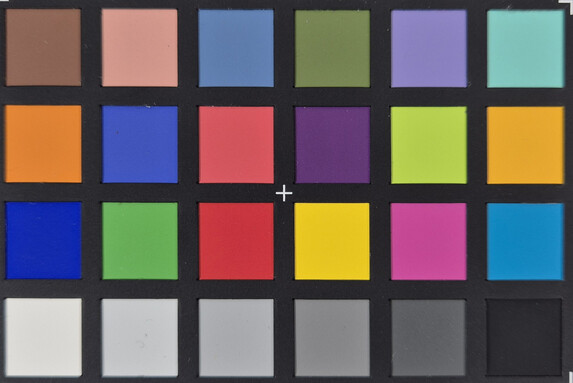
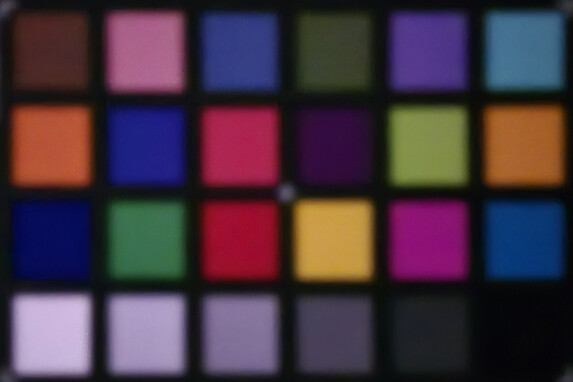
Accessories and warranty - The Samsung phone without a power supply
The phone's scope of delivery doesn't include a charger and straight out of the box, the display doesn't have a protective cover installed. The box only includes a USB cable and information leaflets.
In the United States, the Galaxy smartphone is covered by a standard 12-month limited warranty. Optionally, you can take out an insurance package called Care+ which covers the Galaxy S24+ against damage and theft for up to two years.
Input devices & operation - The Galaxy S24 Plus with Face Unlock
Inputs remain accurate right into the corners of the phone's 6.7-inch touchscreen and they are executed quickly. The Galaxy S24+ can be operated very smoothly and its vibration motor releases crisp haptic feedback.
The Samsung phone uses an ultrasound sensor beneath the OLED panel to authenticate users, which recognizes saved fingerprints quickly and reliably. Biometric security is also provided through a 2D facial unlock function.
Display - The Galaxy smartphone with an extremely bright display
The 6.7-inch AMOLED panel features a refresh rate of up to 120 Hz. The LTPO panel allows for the frequency to be adapted to a minimum of 1 Hz. In our test, however, we only read a minimum of 24 Hz from the system data.
One big difference compared to its predecessor is the screen's pixel density. While the Galaxy S23+ featured a FullHD+ resolution, its successor's screen runs at 1,440p, which is on the same level as a Galaxy S24 Ultra.
In order to regulate its brightness, the Galaxy smartphone uses OLED-typical PWM at a frequency of 240 to 480 Hz. The amplitude curve was very even across the phone's entire brightness spectrum in our measurement using an oscilloscope.
Its maximum brightness of almost 1,400 cd/m² which we measured is very good, and it also did great for the price class during the realistic APL18 test (Average Picture Level), achieving a maximum brightness of 2,610 cd/m². When playing back a 4K-HDR-pattern video, we even measured 2,793 cd/m².
| |||||||||||||||||||||||||
Brightness Distribution: 92 %
Center on Battery: 1358 cd/m²
Contrast: ∞:1 (Black: 0 cd/m²)
ΔE Color 3 | 0.5-29.43 Ø5
ΔE Greyscale 2.5 | 0.57-98 Ø5.3
98.1% sRGB (Calman 2D)
Gamma: 1.98
| Samsung Galaxy S24+ AMOLED, 3120x1440, 6.70 | Samsung Galaxy S23+ Dynamic AMOLED 2x, 2340x1080, 6.60 | Xiaomi 14 Pro AMOLED, 3200x1440, 6.73 | Google Pixel 8 Pro OLED, 2992x1344, 6.70 | Nubia Z60 Ultra AMOLED, 2480x1116, 6.80 | |
|---|---|---|---|---|---|
| Screen | -4% | 11% | 21% | -2% | |
| Brightness middle | 1358 | 1128 -17% | 1025 -25% | 1510 11% | 1003 -26% |
| Brightness | 1358 | 1136 -16% | 1046 -23% | 1467 8% | 1001 -26% |
| Brightness Distribution | 92 | 99 8% | 95 3% | 92 0% | 96 4% |
| Black Level * | |||||
| Colorchecker dE 2000 * | 3 | 2.7 10% | 1.1 63% | 1.1 63% | 1.7 43% |
| Colorchecker dE 2000 max. * | 4.4 | 4.5 -2% | 2.9 34% | 3.8 14% | 3.6 18% |
| Greyscale dE 2000 * | 2.5 | 2.6 -4% | 2.2 12% | 1.7 32% | 3.1 -24% |
| Gamma | 1.98 111% | 2.05 107% | 2.25 98% | 2.23 99% | 2.26 97% |
| CCT | 6656 98% | 6644 98% | 6622 98% | 6670 97% | 6257 104% |
* ... smaller is better
Screen Flickering / PWM (Pulse-Width Modulation)
| Screen flickering / PWM detected | 479 Hz | ||
The display backlight flickers at 479 Hz (worst case, e.g., utilizing PWM) . The frequency of 479 Hz is relatively high, so most users sensitive to PWM should not notice any flickering. However, there are reports that some users are still sensitive to PWM at 500 Hz and above, so be aware. In comparison: 53 % of all tested devices do not use PWM to dim the display. If PWM was detected, an average of 17903 (minimum: 5 - maximum: 3846000) Hz was measured. | |||
Measurement series with fixed zoom level and different brightness settings
Our display color analysis is carried out with the help of a photo spectrometer and CalMAN software. Its color and grayscale deviations were within the target range (<3), however, compared to a Xiaomi 14 Pro or a Pixel 8 Pro, the Galaxy S24+ isn't optimally calibrated.
Display Response Times
| ↔ Response Time Black to White | ||
|---|---|---|
| 1.12 ms ... rise ↗ and fall ↘ combined | ↗ 0.6165 ms rise | |
| ↘ 0.5035 ms fall | ||
| The screen shows very fast response rates in our tests and should be very well suited for fast-paced gaming. In comparison, all tested devices range from 0.1 (minimum) to 240 (maximum) ms. » 2 % of all devices are better. This means that the measured response time is better than the average of all tested devices (21.5 ms). | ||
| ↔ Response Time 50% Grey to 80% Grey | ||
| 2.8 ms ... rise ↗ and fall ↘ combined | ↗ 1.283 ms rise | |
| ↘ 1.514 ms fall | ||
| The screen shows very fast response rates in our tests and should be very well suited for fast-paced gaming. In comparison, all tested devices range from 0.2 (minimum) to 636 (maximum) ms. » 7 % of all devices are better. This means that the measured response time is better than the average of all tested devices (33.7 ms). | ||
Performance - The Galaxy S24 Plus with an Eynos SoC
The Galaxy S24+ relies on a very powerful SoC, namely the Exynos 2400—however, it is slightly weaker than the Snapdragon 8 Gen 3 within the Ultra model. The CPU unit with the fast ARM Cortex X4 in combination with 12 GB RAM ensured good benchmark results. Especially when it came to its Geekbench multi score, the Galaxy S24+ showed improvements compared to its predecessor.
| UL Procyon AI Inference for Android - Overall Score NNAPI | |
| Google Pixel 8 Pro | |
| Average of class Smartphone (207 - 84787, n=150, last 2 years) | |
| Nubia Z60 Ultra | |
| Xiaomi 14 Pro | |
| Samsung Galaxy S23+ | |
| Average Samsung Exynos 2400 (11342 - 11574, n=2) | |
| Samsung Galaxy S24+ | |
In terms of graphics calculations, which the Xclipse 940 iGPU integrated within the Exynos 2400 handles, the Samsung phone again achieved very good results. Thanks to the display's higher pixel density, its on-screen values were (as expected) lower than those of the Galaxy S23+ or Galaxy S24 with a FullHD+ resolution.
GFXBench (DX / GLBenchmark) 2.7: T-Rex Onscreen | 1920x1080 T-Rex Offscreen
GFXBench 3.0: on screen Manhattan Onscreen OGL | 1920x1080 1080p Manhattan Offscreen
GFXBench 3.1: on screen Manhattan ES 3.1 Onscreen | 1920x1080 Manhattan ES 3.1 Offscreen
GFXBench: on screen Car Chase Onscreen | 1920x1080 Car Chase Offscreen | on screen Aztec Ruins High Tier Onscreen | 2560x1440 Aztec Ruins High Tier Offscreen | on screen Aztec Ruins Normal Tier Onscreen | 1920x1080 Aztec Ruins Normal Tier Offscreen | 3840x2160 4K Aztec Ruins High Tier Offscreen
| 3DMark / Wild Life Extreme Unlimited | |
| Nubia Z60 Ultra | |
| Samsung Galaxy S24+ | |
| Samsung Galaxy S23+ | |
| Google Pixel 8 Pro | |
| 3DMark / Wild Life Extreme | |
| Nubia Z60 Ultra | |
| Samsung Galaxy S24+ | |
| Samsung Galaxy S23+ | |
| Google Pixel 8 Pro | |
| 3DMark / Wild Life Unlimited Score | |
| Nubia Z60 Ultra | |
| Samsung Galaxy S23+ | |
| Samsung Galaxy S24+ | |
| Google Pixel 8 Pro | |
| GFXBench (DX / GLBenchmark) 2.7 / T-Rex Onscreen | |
| Samsung Galaxy S23+ | |
| Google Pixel 8 Pro | |
| Xiaomi 14 Pro | |
| Samsung Galaxy S24+ | |
| Nubia Z60 Ultra | |
| GFXBench (DX / GLBenchmark) 2.7 / T-Rex Offscreen | |
| Nubia Z60 Ultra | |
| Xiaomi 14 Pro | |
| Samsung Galaxy S23+ | |
| Samsung Galaxy S24+ | |
| Google Pixel 8 Pro | |
| GFXBench 3.0 / Manhattan Onscreen OGL | |
| Samsung Galaxy S23+ | |
| Google Pixel 8 Pro | |
| Xiaomi 14 Pro | |
| Samsung Galaxy S24+ | |
| Nubia Z60 Ultra | |
| GFXBench 3.0 / 1080p Manhattan Offscreen | |
| Nubia Z60 Ultra | |
| Xiaomi 14 Pro | |
| Samsung Galaxy S24+ | |
| Samsung Galaxy S23+ | |
| Google Pixel 8 Pro | |
| GFXBench 3.1 / Manhattan ES 3.1 Onscreen | |
| Samsung Galaxy S23+ | |
| Xiaomi 14 Pro | |
| Samsung Galaxy S24+ | |
| Google Pixel 8 Pro | |
| Nubia Z60 Ultra | |
| GFXBench 3.1 / Manhattan ES 3.1 Offscreen | |
| Nubia Z60 Ultra | |
| Xiaomi 14 Pro | |
| Samsung Galaxy S24+ | |
| Samsung Galaxy S23+ | |
| Google Pixel 8 Pro | |
| GFXBench / Car Chase Onscreen | |
| Samsung Galaxy S23+ | |
| Xiaomi 14 Pro | |
| Google Pixel 8 Pro | |
| Samsung Galaxy S24+ | |
| Nubia Z60 Ultra | |
| GFXBench / Car Chase Offscreen | |
| Nubia Z60 Ultra | |
| Xiaomi 14 Pro | |
| Samsung Galaxy S24+ | |
| Samsung Galaxy S23+ | |
| Google Pixel 8 Pro | |
| GFXBench / Aztec Ruins High Tier Onscreen | |
| Samsung Galaxy S23+ | |
| Xiaomi 14 Pro | |
| Samsung Galaxy S24+ | |
| Google Pixel 8 Pro | |
| Nubia Z60 Ultra | |
| GFXBench / Aztec Ruins High Tier Offscreen | |
| Nubia Z60 Ultra | |
| Xiaomi 14 Pro | |
| Samsung Galaxy S24+ | |
| Samsung Galaxy S23+ | |
| Google Pixel 8 Pro | |
| GFXBench / Aztec Ruins Normal Tier Onscreen | |
| Samsung Galaxy S23+ | |
| Xiaomi 14 Pro | |
| Google Pixel 8 Pro | |
| Samsung Galaxy S24+ | |
| Nubia Z60 Ultra | |
| GFXBench / Aztec Ruins Normal Tier Offscreen | |
| Nubia Z60 Ultra | |
| Xiaomi 14 Pro | |
| Samsung Galaxy S24+ | |
| Samsung Galaxy S23+ | |
| Google Pixel 8 Pro | |
| GFXBench / 4K Aztec Ruins High Tier Offscreen | |
| Nubia Z60 Ultra | |
| Xiaomi 14 Pro | |
| Samsung Galaxy S24+ | |
| Samsung Galaxy S23+ | |
| Google Pixel 8 Pro | |
| Jetstream 2 - Total Score | |
| Nubia Z60 Ultra (Edge 120) | |
| Nubia Z60 Ultra (Chrome 121) | |
| Samsung Galaxy S23+ (Chrome 110.0.5481.65) | |
| Xiaomi 14 Pro (Chrome 120) | |
| Samsung Galaxy S24+ (Chrome 121) | |
| Average Samsung Exynos 2400 (128.6 - 139.1, n=2) | |
| Average of class Smartphone (13.8 - 351, n=173, last 2 years) | |
| Google Pixel 8 Pro (Chrome 117) | |
| Speedometer 2.0 - Result | |
| Average Samsung Exynos 2400 (260 - 267, n=2) | |
| Samsung Galaxy S24+ (Chrome 121) | |
| Nubia Z60 Ultra (Edge 120) | |
| Google Pixel 8 Pro (Chrome 117) | |
| Samsung Galaxy S23+ (Chrome 110.0.5481.65) | |
| Xiaomi 14 Pro (Chrome 120) | |
| Average of class Smartphone (14.9 - 445, n=157, last 2 years) | |
| WebXPRT 4 - Overall | |
| Xiaomi 14 Pro (Chrome 120) | |
| Samsung Galaxy S24+ (Chrome 121) | |
| Average Samsung Exynos 2400 (176 - 176, n=2) | |
| Nubia Z60 Ultra (Edge 120) | |
| Samsung Galaxy S23+ (Chrome 110.0.5481.65) | |
| Google Pixel 8 Pro (Chrome 117) | |
| Average of class Smartphone (22 - 202, n=160, last 2 years) | |
| WebXPRT 3 - Overall | |
| Xiaomi 14 Pro (Chrome 120) | |
| Average of class Smartphone (39 - 304, n=122, last 2 years) | |
| Google Pixel 8 Pro (Chrome 117) | |
| Samsung Galaxy S24+ | |
| Octane V2 - Total Score | |
| Nubia Z60 Ultra (Edge 120) | |
| Average Samsung Exynos 2400 (63452 - 63748, n=2) | |
| Samsung Galaxy S24+ (Chrome 121) | |
| Samsung Galaxy S23+ (Chrome 110.0.5481.65) | |
| Xiaomi 14 Pro (Chrome 120) | |
| Google Pixel 8 Pro (Chrome 117) | |
| Average of class Smartphone (2228 - 89112, n=214, last 2 years) | |
| Mozilla Kraken 1.1 - Total | |
| Average of class Smartphone (388 - 9999, n=173, last 2 years) | |
| Google Pixel 8 Pro (Chrome 117) | |
| Xiaomi 14 Pro (Chrome 120) | |
| Samsung Galaxy S23+ (Chrome 110.0.5481.65) | |
| Average Samsung Exynos 2400 (631 - 662, n=2) | |
| Nubia Z60 Ultra (Edge 120) | |
| Samsung Galaxy S24+ (Chrome 121) | |
* ... smaller is better
Thanks to its high performance and fast storage, you won't face any noticeable delays in everyday use and the system runs buttery smooth in almost every situation. Similar to the Galaxy S24, however, its read and write rates lie slightly below what we expect of the UFS-4.0 standard.
| Samsung Galaxy S24+ | Samsung Galaxy S23+ | Google Pixel 8 Pro | Nubia Z60 Ultra | Average 512 GB UFS 4.0 Flash | Average of class Smartphone | |
|---|---|---|---|---|---|---|
| AndroBench 3-5 | 1% | -34% | 128% | 90% | -12% | |
| Sequential Read 256KB | 2450.9 | 3250.14 33% | 1501.13 -39% | 3926.73 60% | 3712 ? 51% | 1508 ? -38% |
| Sequential Write 256KB | 1523.87 | 1014.33 -33% | 257.28 -83% | 3518.47 131% | 3042 ? 100% | 1118 ? -27% |
| Random Read 4KB | 387.42 | 441.77 14% | 156.16 -60% | 477.73 23% | 416 ? 7% | 247 ? -36% |
| Random Write 4KB | 176.19 | 156.82 -11% | 258.92 47% | 701.13 298% | 530 ? 201% | 272 ? 54% |
| Samsung Galaxy S24+ | Xiaomi 14 Pro | Nubia Z60 Ultra | Samsung Galaxy S24 | Average 512 GB UFS 4.0 Flash | Average of class Smartphone | |
|---|---|---|---|---|---|---|
| PCMark for Android | 8% | 70% | -5% | 51% | -8% | |
| Storage 2.0 seq. read int. | 2327 ? | 2075 ? -11% | 3428.59 47% | 2345 ? 1% | 2647 ? 14% | 1549 ? -33% |
| Storage 2.0 seq. write int. | 1201 ? | 2300 ? 92% | 2541.76 112% | 1108 ? -8% | 2531 ? 111% | 1315 ? 9% |
| Storage 2.0 random read int. | 50 ? | 20.9 ? -58% | 65.78 32% | 50.9 ? 2% | 56.1 ? 12% | 38.6 ? -23% |
| Storage 2.0 random write int. | 66.7 ? | 28 ? -58% | 90.19 35% | 64.4 ? -3% | 86.3 ? 29% | 59.7 ? -10% |
| Storage 2.0 | 25276 ? | 35634 41% 35634 ? 41% | 56018 122% | 21538 ? -15% | 47833 ? 89% | 29868 ? 18% |
Games - The Galaxy S24 Plus manages over 100 fps
Let's take a look at whether the Xclipse 940 iGPU is also suitable for HFR gaming with the help of the GameBench application. In games with low system requirements, such as the first-person shooter Dead Trigger 2, an average of over 100 fps is possible using the Galaxy S24+. Modern games, such as PUBG Mobile, can only be played at a high 90 fps using the lowest graphics setting. At the highest detail level (UHD), the Samsung phone runs at 40 fps. Our third game, the demanding Genshin Impact, is displayed at 60 fps on the Galaxy S24+ in the highest graphics setting.
Emissions - The Samsung phone gets warm
Temperature
In our measurements, the phone's surface temperatures were quite high. Compared to the Galaxy S24, however, the Plus model completed our Burnout benchmark under standard test conditions (CPU+GPU). In the Wildlife stress tests of 3DMark, the Galaxy S24+ showed a moderate performance loss of about 20 per cent.
(-) The maximum temperature on the upper side is 49.5 °C / 121 F, compared to the average of 35 °C / 95 F, ranging from 21.9 to 56 °C for the class Smartphone.
(-) The bottom heats up to a maximum of 48.1 °C / 119 F, compared to the average of 33.8 °C / 93 F
(+) In idle usage, the average temperature for the upper side is 25.4 °C / 78 F, compared to the device average of 32.7 °C / 91 F.
3DMark Wild Life Stress Test
| 3DMark | |
| Wild Life Stress Test Stability | |
| Samsung Galaxy S24+ | |
| Google Pixel 8 Pro | |
| Nubia Z60 Ultra | |
| Samsung Galaxy S23+ | |
| Wild Life Extreme Stress Test | |
| Samsung Galaxy S24+ | |
| Nubia Z60 Ultra | |
| Google Pixel 8 Pro | |
| Samsung Galaxy S23+ | |
| Solar Bay Stress Test Stability | |
| Nubia Z60 Ultra | |
| Samsung Galaxy S24+ | |
Speakers
The Samsung phone's stereo speakers impressed us with a pleasant sound quality and even trebles. However, the Galaxy S24+'s speakers do not produce much bass. The mids are balanced but could be a little more linear.
If you want to play music externally, you can use the wired USB-C port, or Bluetooth 5.3 is also available. However, the latter uses comparatively few codecs (SBC, AAC, aptX, LDAC and SSC).
Samsung Galaxy S24+ audio analysis
(+) | speakers can play relatively loud (92.1 dB)
Bass 100 - 315 Hz
(-) | nearly no bass - on average 22.3% lower than median
(+) | bass is linear (5.2% delta to prev. frequency)
Mids 400 - 2000 Hz
(±) | reduced mids - on average 6.5% lower than median
(+) | mids are linear (4.8% delta to prev. frequency)
Highs 2 - 16 kHz
(±) | higher highs - on average 5.6% higher than median
(+) | highs are linear (1.8% delta to prev. frequency)
Overall 100 - 16.000 Hz
(±) | linearity of overall sound is average (17.3% difference to median)
Compared to same class
» 8% of all tested devices in this class were better, 6% similar, 86% worse
» The best had a delta of 12%, average was 38%, worst was 134%
Compared to all devices tested
» 27% of all tested devices were better, 8% similar, 65% worse
» The best had a delta of 4%, average was 25%, worst was 134%
Samsung Galaxy S23+ audio analysis
(+) | speakers can play relatively loud (91.8 dB)
Bass 100 - 315 Hz
(-) | nearly no bass - on average 21.7% lower than median
(+) | bass is linear (5.8% delta to prev. frequency)
Mids 400 - 2000 Hz
(±) | reduced mids - on average 5.8% lower than median
(+) | mids are linear (4.3% delta to prev. frequency)
Highs 2 - 16 kHz
(+) | balanced highs - only 4.4% away from median
(+) | highs are linear (2.6% delta to prev. frequency)
Overall 100 - 16.000 Hz
(±) | linearity of overall sound is average (16.2% difference to median)
Compared to same class
» 4% of all tested devices in this class were better, 4% similar, 93% worse
» The best had a delta of 12%, average was 38%, worst was 134%
Compared to all devices tested
» 21% of all tested devices were better, 5% similar, 74% worse
» The best had a delta of 4%, average was 25%, worst was 134%
Battery life - The Samsung phone with wireless charging
Power consumption
Its power consumption values are unremarkable. As expected, its power consumption under load is significantly higher than that of the Galaxy S23+ in view of the Burnout benchmark.
The phone's 4,900 mAh battery, which has grown in size compared to its predecessor, can be recharged in around 80 minutes at a maximum of 45 watts from zero—assuming a correspondingly powerful energy source. We used a power bank (100 watts, PD 3.0) in our test, as there was no suitable power adapter included in the scope of delivery. The Galaxy S24+ is capable of wireless charging at up to 15 watts, as well as Wireless PowerShare at up to 5 watts.
| Off / Standby | |
| Idle | |
| Load |
|
| Samsung Galaxy S24+ 4900 mAh | Samsung Galaxy S23+ 4700 mAh | Xiaomi 14 Pro 4880 mAh | Google Pixel 8 Pro 5050 mAh | Nubia Z60 Ultra 6000 mAh | Average Samsung Exynos 2400 | Average of class Smartphone | |
|---|---|---|---|---|---|---|---|
| Power Consumption | 9% | -28% | -33% | -71% | -15% | -37% | |
| Idle Minimum * | 0.43 | 0.64 -49% | 0.89 -107% | 0.63 -47% | 0.69 -60% | 0.425 ? 1% | 0.897 ? -109% |
| Idle Average * | 0.84 | 0.88 -5% | 1.05 -25% | 1.47 -75% | 1.52 -81% | 0.885 ? -5% | 1.452 ? -73% |
| Idle Maximum * | 0.95 | 0.94 1% | 1.11 -17% | 1.55 -63% | 1.6 -68% | 1.01 ? -6% | 1.629 ? -71% |
| Load Average * | 6.76 | 4.18 38% | 9.03 -34% | 8.45 -25% | 14.73 -118% | 11.1 ? -64% | 5.55 ? 18% |
| Load Maximum * | 16.42 | 6.59 60% | 9.06 45% | 8.63 47% | 20.82 -27% | 16.5 ? -0% | 8.31 ? 49% |
* ... smaller is better
Power consumption: Geekbench (150 cd/m²)
Power consumption: GFXBench (150 cd/m²)
Runtimes
In our WLAN test using an adapted display brightness of 150 cd/m2, the Galaxy S24+ lasted for around 17 hours, which may be less than its predecessor, but it is still a very good result.
| Battery Runtime - WiFi v1.3 | |
| Samsung Galaxy S24+ | |
| Samsung Galaxy S23+ | |
| Xiaomi 14 Pro | |
| Google Pixel 8 Pro | |
| Nubia Z60 Ultra | |
Pros
Cons
Verdict on the Samsung Galaxy S24 Plus
The Galaxy S24+ is the less compact and heavier—but also larger—version of the Galaxy S24. Not only thanks to its features (WQHD+ resolution, 12 GB RAM, 512 GB of internal storage, ...) does the Plus model position itself between the two other Galaxy S24 smartphones, but it also offers some clear advantages over its smaller sister model in terms of efficiency, as it produces less heat. Its better cooling system leads to the Exynos 2400 consuming less under load and to much more constant performance. Despite its higher pixel density, its long runtimes continue to be a big advantage of the Galaxy S24+.
If you are willing to make some compromises when it comes to the Samsung phone's first-class update delivery, then the Xiaomi 14 Pro and Nubia Z60 Ultra may be two interesting top-of-the-range alternatives—and both feature the Snapdragon 8 Gen 3. The Pixel 8 Pro is also an exciting alternative to the Galaxy S24+ thanks to its better camera package.
Thanks to the Galaxy S24+'s many improvements, Samsung has given its high-end phone more independence within the S24 series.
Price and availability
Currently, the Samsung Galaxy S24+ can be found on Amazon for US$999.99.
Samsung Galaxy S24+
-
03/08/2024 v7
Marcus Herbrich
Transparency
The present review sample was made available to the author as a loan by the manufacturer or a shop for the purposes of review. The lender had no influence on this review, nor did the manufacturer receive a copy of this review before publication. There was no obligation to publish this review.


 Deutsch
Deutsch English
English Español
Español Français
Français Italiano
Italiano Nederlands
Nederlands Polski
Polski Português
Português Русский
Русский Türkçe
Türkçe Svenska
Svenska Chinese
Chinese Magyar
Magyar